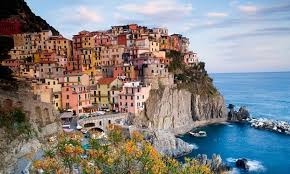Want to enjoy Italy away from crowds?

Rome: If you want to enjoy Italy away from the crowds, you can often do so by heading to one of the country’s many evocative villages. But if you prefer a more urban setting without having to deal with the tourist throngs in Rome, Florence and Venice, try a lesser-known city destination like the five described below (four have UNESCO World Heritage designation), ranging in location from the Alpine north to Sicily.
Trento. In this flourishing city in northern Italy’s Trentino-Alto Adige/Südtirol region, medieval meets modern and Italian culture comes with an Austro-Alpine overlay. You can hop from the richly frescoed Buonconsiglio Castle, whose centuries-long construction began in the Middle Ages, to Renzo Piano’s MUSE, a science museum that’s home to Alpine nature and glacier exhibits. Visit other starchitect landmarks in the region, such as the Museum of Modern and Contemporary Art of Trento and Rovereto (MART) designed by Mario Botta, to see works by leading 20th-century artists like Giorgio Morandi, Giorgio de Chirico and Fortunate Depero, the prominent Futurist painter who grew up in the Trentino. (Rovereto is about 27 kilometers from Trento.) Farther away (a drive of about two hours and 15 minutes) is Zaha Hadid’s Messner Mountain Museum, Corones, focused on mountain history and culture and located on the Kronplatz summit plateau (2,275 meters). Wherever you decide to visit, make time in late afternoon to stop at a caffè in the historic Piazza Duomo, a thriving square considered among the most exquisite in Italy. Order a glass of one of the highly regarded Trento DOC sparkling wines produced in the area. When dining keep in mind the pastas can be hearty–local dishes include strangolapreti (here in the form of spinach dumplings) and canederli, dumplings made with cheese and ham and served in a broth.
Mantua (Mantova). A splendid Renaissance city with a rich local cuisine, Mantua should have a higher profile among international travelers, who may only know it as the place where Romeo was banished in Shakespeare’s Romeo and Juliet. Although culturally prominent for centuries, Mantua has racked up recent accolades, being named an Italian Capital of Culture and UNESCO World Heritage Site. As in other Italian cities, a powerful dynasty—in this case the Gonzagas—shaped its destiny, with Mantua becoming an artistic mecca during the 15th and 16th centuries. You’ll find a number of palaces (visit the Palazzo Ducale, where the Gonzaga family lived, and the Palazzo del Te, built for a Gonzaga duke); a lavish theater, the Teatro Bibiena, where Mozart performed; and splendid squares, like the cobblestone Piazza Sordello, great for absorbing the local vibe (market day is Thursday). Stop by for a coffee or aperitif at the historic Bar Caravatti and be sure to sample the sublime local pasta, tortelli di zucca, at a fine restaurant like Il Cigno. The 13th-century Palazzo Castiglioni near the Ducal Palace houses a number of luxury suites. The palazzo is still home to the Castiglioni family, whose ancestor, Baldassare, wrote the famous Il Cortegiano, or The Book of the Courtier.
Ferrara. This city has connections to some of the Renaissance’s most famous women—powerhouse arts patron Isabella d’Este, the daughter of Duke Ercole d’Este, was born and grew up here; and the controversial Lucrezia Borgia, who unusually for her time, held a prominent political position as governor of Spoleto, and (not unusually for her class) married advantageously three times—her last spouse was Alfonso d’Este, the Duke of Ferrara. Starting in the 13th century the Este dynasty held sway over Ferrara for more than 350 years; at their court were some of the best-known artists of the Renaissance, among them Bellini, Mantegna, and Titian. You can visit their hefty castle in the center of town (there’s even a moat) and a number of their other properties, the Estensi villas, in the Ferrara countryside. At the Palazzo dei Diamanti (also a former d’Este residence), there’s the National Art Gallery of Ferrara, with pieces from Este private collections. If you’re in Ferrara in early June take in the historic palio (horse race) on Sunday, June 2—the first one was held here in 1259. Make sure to stop by Al Brindisi, a tavern dating to 1435; clients have included the the artist Titian, and Copernicus lived in the flat above the ostaria. Wherever you eat in Ferrara, try the city’s specials like pasticcio alla ferrarese, a baked pasta pie, and the memorably named sguazabarbuz, a bean and pasta soup.
Catania. Mixing grit and magnificence and a deeply layered history—its millennia-spanning roster of invaders left impressive reminders of their days here—Catania offers everything from significant Roman ruins to dazzling Baroque palazzi and churches (some of which are designated as a UNESCO World Heritage Site). Mt. Etna, the still active volcano, is another power that has ruled over the city—Catania lies at its base—but intrepid vintners have tamed its lava-and-ash-doused slopes, producing top wines for the Etna DOC. Although colored by the past, Catania offers a young vibe, thanks to the university’s large student population. When the temperatures soar, head to one of the nearby beach areas like La Playa or the Riviera dei Ciclopi, about 12 kilometers to the north. Being by the water means a coastal Italian cuisine offering plenty of great seafood (the local fish market is an experience in itself), like fish stews, grilled swordfish and fried calamari among many options. The eggplant pastas and citrus granitas are area specialties too.
Noto. Filled with majestic buildings and churches, Noto is a showcase for Sicilian Baroque architecture, a place of heavenly beauty, especially in late afternoon when the setting sun casts the limestone facades with a tawny glow. Noto is also renowned for its Infiorata, an annual event that draws many visitors and turns the Via Nicolaci into a sumptuous floral carpet, where artists render intricate designs with thousands of flowers. This year’s Infiorata takes place May 17-19 with the theme “The Sicilians in America.” While in Noto, make sure to try the gelatos, sorbets and granitas (must-stops include the Dolceria Costanzo and Caffè Sicilia), considered among the best in Italy. For lodging, check out the Seven Rooms Villadorata, a beautifully designed boutique property in a private wing of the Palazzo Nicolaci





